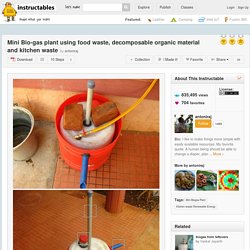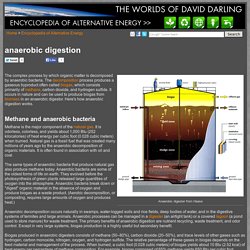

Mini Bio-gas plant using food waste, decomposable organic material and kitchen waste. I have been searching for some method of using the food waste, decomposable organic material and kitchen waste efficiently, and came across information on producing bio-gas from organic waste.

The bio-gas produced from food waste, decomposable organic material and kitchen waste, consisting of methane and a little amount of carbon di oxide is an alternative fuel for cooking gas (LPG). Also, the waste materials can be disposed off efficiently without any odor or flies and the digested slurry from the bio-gas unit can be used as an organic manure in the garden. Components of the Bio-gas Plant The major components of the bio-gas plant are a digester tank, an inlet for feeding the kitchen waste, gas holder tank, an outlet for the digested slurry and the gas delivery system for taking out and utilizing the produced gas.
This project is also useful for students to have a hands-on learning experience in constructing a Mini Bio-Gas Plant, using locally available material. Material Required: 6 biodigesteur. Wikitionary - Biogaz. Définition, traduction, prononciation, anagramme et synonyme sur le dictionnaire libre Wiktionnaire.

Français[modifier | modifier le wikicode] Étymologie[modifier | modifier le wikicode] De gaz et bio, biologique. Nom commun[modifier | modifier le wikicode] biogaz masculin Le biogaz est le gaz produit par la fermentation de matières organiques animales (purin) ou végétales en l'absence d'oxygène. Synonymes[modifier | modifier le wikicode]
David Wargert - Biogas in developing rural areas. ARTI - Compact biogas plant Construction introduction Part 1. ARTI - Compact biogas plant step by step Construction Part 2. ARTI - Compact biogas plant (Anaerobic Digester)step by step Construction Part 3. ARTI - Compact biogas plant (Anaerobic Digester)step by step Construction Part 4. Practical Answers - Utiliser un Digesteur de Biogaz. Practical Answers - Utilisation de la Technologie du Biogaz. Practical Answers - Le Biogaz. Practical Answers - biogas plants in animal husbandry stock farming for poor. Practical Answers - Costs and benefits of a biogas plant and implementation. Practical Answers - Biogas plant product development procedure and planning. Practical Answers - Basics of producing using biogas from dung and organic waste.
MDG - How to make a Bio-gas Digester. SENS - Manuel réalisation Digesteur Low Tech. AIDG - Tutorial De Construction de Bio-Digesteur. ACLES - Atelier Biodigesteur Agou 2008. Prisme - Biogaz a des fins domestiques. EDEN - Digesteur de demonstration. Sistema Biobolsa - Produccion de Biogas. Daviddarling.info - Anaerobic digestion. The complex process by which organic matter is decomposed by anaerobic bacteria.

The decomposition process produces a gaseous byproduct often called biogas, which consists primarily of methane, carbon dioxide, and hydrogen sulfide. It occurs in nature and can be used to produce biogas from biomass in an anaerobic digestor. Here's how anaerobic digestion works. Methane and anaerobic bacteria Methane is the major component of the natural gas. The same types of anaerobic bacteria that produce natural gas also produce methane today.
Anaerobic decomposition occurs naturally in swamps, water-logged soils and rice fields, deep bodies of water, and in the digestive systems of termites and large animals. Biogas produced in anaerobic digesters consists of methane (50–80%), carbon dioxide (20–50%), and trace levels of other gases such as hydrogen, carbon monoxide, nitrogen, oxygen, and hydrogen sulfide. Anaerobic digestion Anaerobic decomposition is a complex process. Sludge or effluent Related entry. Amateur - Storing biogas in a plastic trash bag. João Amarante - Technologies disponibles et enjeux biométhanisation des déchets. Econologie.com - Biogaz méthanisation et pouvoir méthanogène. Suite à de nombreuses intérrogation concernant le biogaz et le fait de pouvoir l'utiliser pour son autonomie énergétique, voici quelques petits calculs d'estimation.

Basé sur ce documents de l'Ademe : Page 5 et 19, il y a les bilans "intrants-energie" des 2 installations. Prenons comme exemple la 2ieme page 19 : Il faut 2.542 Tonnes (dont 1264 T purement liquide soit 50% de matiere solide) pour 156.996 m3 de biogaz ayant produit : 313.000 kwhe et 626.000 kwhth avec un rendement global de 80 (elec + chaleur) on obtient donc 1 174 000 kwhe d'énergie "brute" pour 156 996 m3. Soit un PCI du biogaz de l'ordre de 7,5 kwh (1 m3 de gaz naturel ou 1L de fioul = environ 10 kwh) et donc 0,75 L de fioul. Or il faut 2542/157 = 16,2 kg de "matiere entrant" pour faire un 1m3 de biogaz soit 0,75L de fioul. Il faut donc grosso modo 16,2/0,75 = 21,6 kg à 50% de liquide (au moins) pour faire 1 L. Hybrid Energies - Fabrication d'un biodigesteur familial.